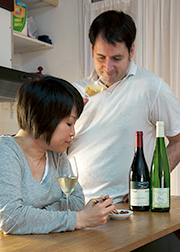While residual sugar in wine pairs extremely well with hot spices used in other Asian countries, it is the sweetness in the milder Japanese cuisine which matches the intense fruit of these wines. Sugar is a common ingredient in various preparations, but one must be careful not to overwhelm some of the more delicate dishes.
Below, you’ll find the major styles, from off-dry to sweet dessert wines, along with examples of appellations or grape varieties which fit into those categories, and their usual price points ($ – under $15, $$ – between $15 and $50, $$$ – over $50).
Because of its particular characteristics Riesling is further covered on a dedicated page.
Special Terms:
BA = Beerenauslese
TBA = Trockenbeerenauslese
VT = Vendanges Tardives
SGN = Selection de Grains Nobles
Off-Dry Whites (Demi-Sec)
While the sweetness in these wines is noticeable, they remain rather light and elegant which is great for pairing with more delicate ingredients such as seafood, including nigiri, chirashi, or maki sushi which actually contain sugar in the rice. Off-dry whites also work well with more flavorful seafood.
Best pairings: nigiri sushi (shake, anago, amaebi), kaki-fry, tamago- or oyako -don, crab sunamono
$ – $$ : Vouvray demi-sec, Germany/Austria halbtrocken or Kabinett
Semi-Sweet Whites (Moelleux)
These wines offer very intense fruit aromas and a marked sweetness, though they not as rich and powerful as dessert wines.
Best pairings: gomoku-zushi, inari-zushi, unagi, chicken teriyaki, shiokara, nikujaga
$ – $$ : Vouvray Moelleux, Coteaux du Layon, Coteaux de l’Aubance, Anjou Coteaux de la Loire, Jurançon
$$ : Bonnezeaux, Quarts de Chaume, Alsace VT, Germany/Austria Spätlese or Auslese
Sweet Whites
Rich and concentrated, these dessert wines will overpower most Japanese dishes, though some flavorful seafood or meats served with sauce or tare can provide enough sweetness to counter the tropical or candied fruit aromas. And because the extremely rich texture of ankimo resembles foie gras, it also makes sense to pair it with the traditional Monbazillac or Sauternes.
Best pairings: ankimo, hijiki, umeboshi
$$ : Monbazillac, Cadillac, Loupiac, Jura Vin de Paille, Vinosanto, Vin Santo, Recciotto di Soave
$$ – $$$ : Sauternes, Tokay, Alsace SGN, Germany BA, TBA and Eiswein, Austria BA, Ausbruch, TBA, Strohwein and Eiswein, Canada Ice Wine (Niagara)
Sweet or Fortified Reds
Again, one must turn to sweet Japanese sauces to find a worthy match for the aromatic power of these red dessert wines. In this color, anko red bean–based desserts become a more suitable match than with the whites, which have little in common on an aromatic level. The addition of tannins also makes these wines more appropriate for red meats.
Best pairings: beef teriyaki, anko (red bean paste)
$ – $$ : Porto, Banyuls, Maury, Rasteau, Recciotto della Valpolicella
Sweet Sparkers
See here.





